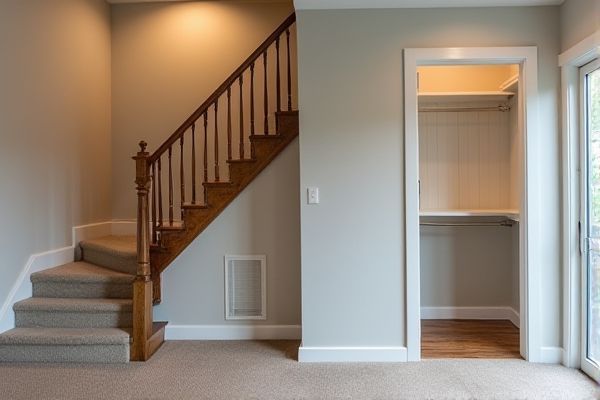
Under stair storage maximizes unused space beneath staircases for compact, easily accessible organization, while basement closets offer larger, climate-controlled areas ideal for bulk storage or seasonal items. Explore the rest of the article to discover which option best suits your home storage needs and lifestyle.
Table of Comparison
| Feature | Under Stair Storage | Basement Closet |
|---|---|---|
| Location | Utilizes space beneath the staircase | Located in the basement area |
| Space Efficiency | Maximizes unused stair space | Offers larger, dedicated storage area |
| Accessibility | Easy access from main living floors | Requires going to basement level |
| Natural Light | Typically limited or no natural light | May have windows, better lighting options |
| Moisture Risk | Generally low moisture, safer for items | Higher moisture risks; potential for dampness |
| Customization | Limited due to shape and size constraints | More flexible design options |
| Cost | Lower renovation and maintenance costs | Potentially higher due to basement conditions |
| Ideal Uses | Storing shoes, cleaning supplies, small items | Bulk storage, seasonal items, tools, larger items |
Introduction: Maximizing Home Storage Space
Under stair storage provides a clever use of often overlooked space beneath the staircase, offering custom compartments and shelves ideal for organizing shoes, books, or seasonal items. Basement closets typically offer larger, more flexible storage options with climate-controlled environments ideal for bulkier items, seasonal gear, or household supplies. Choosing between under stair storage and basement closets depends on home layout, storage needs, and accessibility priorities.
Under Stair Storage: Overview and Benefits
Under stair storage maximizes unused space by transforming the area beneath your staircase into organized compartments, offering convenient access for everyday items. This solution enhances home efficiency by providing customized shelving, drawers, or cabinets that fit seamlessly into complex staircase shapes. Compared to basement closets, under stair storage reduces clutter in distant areas, keeping belongings within easy reach while maintaining aesthetic appeal.
Basement Closet: Overview and Advantages
Basement closets offer spacious storage solutions with consistent temperature and humidity levels, ideal for preserving sensitive items. Unlike under stair storage, basement closets provide greater security and organization opportunities with built-in shelving or custom configurations. You benefit from maximizing your home's unused areas while keeping belongings easily accessible and protected from environmental damage.
Space Utilization Compared: Under Stairs vs Basement Closet
Under stair storage maximizes otherwise unused vertical space, providing accessible and compact storage options ideal for smaller homes or specific items like shoes and cleaning supplies. Basement closets offer larger, more flexible storage areas suitable for bulky items, seasonal goods, and long-term storage but may require more effort to access regularly. Choosing between the two depends on the available square footage, storage needs, and ease of access preferences.
Accessibility and Convenience Factors
Under stair storage offers immediate accessibility, making it ideal for frequently used items due to its location within living spaces. Basement closets, while providing larger storage capacity, often require descending stairs, which can limit convenience for daily access. Your choice depends on balancing ease of reach with storage needs, with under stair spaces favoring quick retrieval and basement closets supporting bulkier or seasonal storage.
Cost and Installation Requirements
Under stair storage typically incurs lower costs and requires minimal installation efforts compared to a basement closet, which often demands extensive construction and moisture-proofing. You can optimize your budget by utilizing existing space beneath stairs with custom shelving or drawers, avoiding the higher labor and material expenses tied to basement modifications. Basement closets may require professional waterproofing and insulation, significantly increasing both time and overall project costs.
Design Flexibility and Customization
Under stair storage offers exceptional design flexibility by utilizing often-overlooked spaces, allowing for tailored compartments that fit your specific needs and room layout. Basement closets provide a larger, more traditional storage area but may lack the customized, multi-functional options that under stair storage can deliver. Your choice depends on whether you prioritize maximized space efficiency and bespoke organization or a more conventional, spacious storage solution.
Ideal Uses for Under Stair Storage
Under stair storage maximizes typically unused space, making it ideal for storing seasonal items, cleaning supplies, or small household tools. Its accessibility suits frequently used belongings, enhancing convenience in kitchens, living rooms, or entryways. You can efficiently organize shoes, outerwear, or children's toys, creating a clutter-free environment without sacrificing floor space.
Best Uses for a Basement Closet
Basement closets excel at providing dry, secure storage space ideal for seasonal items, tools, and bulk household supplies, ensuring easy organization and access. Unlike under stair storage, basement closets can accommodate larger or less frequently used items without compromising living space. Their cool, stable environment makes them perfect for storing preserves, sports equipment, and emergency supplies safely.
Choosing the Right Storage Solution for Your Home
Under stair storage maximizes unused space by fitting seamlessly beneath staircases, ideal for compact homes needing accessible yet discreet organization. Basement closets offer larger capacity and climate control, suitable for storing seasonal items or bulk supplies in cooler, stable conditions. Evaluating available space, accessibility, and storage needs helps determine whether under stair storage or a basement closet better suits your home's functional design.
 homyna.com
homyna.com